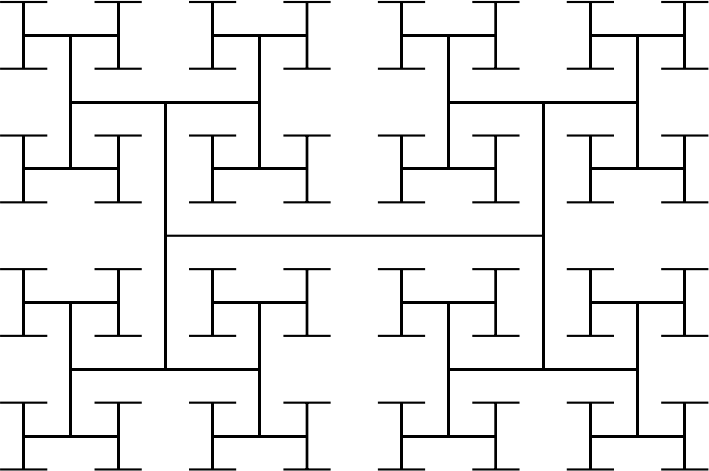An H-tree in TikZ
Via Walking Randomly's post Fractals on Wolfram Alpha – an update I stumbled upon his previous post Plotting Fractals with Wolfram Alpha. And something struck me, I invented / discovered those H-trees when I was a little kid! I remember drawing them when I was in second grade (you're 7 years old then, at least in Belgium), enjoying the laborious yet beautiful nature of them. I also drew gigantic heaps of blocks in oblique projection, oh, how many sheets of grid paper (5 by 5 millimetre) I have filled that way... I guess I was the weird kid of our class.
I wanted to board train nostalgia and draw them in TikZ. And this was even easier than I imaged, as there is a library for fractal decorations! If only TikZ did the dishes. Based on the code I found in $TEXMF/tex/generic/pgf/libraries/pgflibrarydecorations.fractals.code.tex I quickly hacked together the following code:
\pgfdeclaredecoration{H-tree}{init}
{
\state{init}[width=\pgfdecoratedinputsegmentremainingdistance]
{
\pgfpathmoveto{\pgfpoint{0pt}{0.35355\pgfdecoratedinputsegmentremainingdistance}}
\pgfpathlineto{\pgfpoint{0pt}{-0.35355\pgfdecoratedinputsegmentremainingdistance}}
\pgfpathmoveto{\pgfpoint{0pt}{0pt}}
\pgfpathlineto{\pgfpoint{\pgfdecoratedinputsegmentremainingdistance}{0pt}}
\pgfpathmoveto{\pgfpoint{\pgfdecoratedinputsegmentremainingdistance}{0.35355\pgfdecoratedinputsegmentremainingdistance}}
\pgfpathlineto{\pgfpoint{\pgfdecoratedinputsegmentremainingdistance}{-0.35355\pgfdecoratedinputsegmentremainingdistance}}
\pgfpathmoveto{\pgfpoint{\pgfdecoratedinputsegmentremainingdistance}{0pt}}
}
}
This code must be either placed in $TEXMF/tex/generic/pgf/libraries/pgflibrarydecorations.fractals.code.tex or the file itself (or your personal contain-it-all package, just someplace where it can be found).
Now you just draw a tikzpicture with a single recursively decorated line:
\begin{tikzpicture}[decoration=H-tree]
\draw decorate{decorate{decorate{decorate{decorate{decorate{ (0,0) -- (5,0) }}}}}};
\end{tikzpicture}

I hope I got the factor right, but I guess 1/(2sqrt(2)) is the one I needed. A complete minimal working example is given:
\documentclass{minimal}
\usepackage{tikz}
\usetikzlibrary{decorations.fractals}
\pgfdeclaredecoration{H-tree}{init}
{
\state{init}[width=\pgfdecoratedinputsegmentremainingdistance]
{
\pgfpathmoveto{\pgfpoint{0pt}{0.35355\pgfdecoratedinputsegmentremainingdistance}}
\pgfpathlineto{\pgfpoint{0pt}{-0.35355\pgfdecoratedinputsegmentremainingdistance}}
\pgfpathmoveto{\pgfpoint{0pt}{0pt}}
\pgfpathlineto{\pgfpoint{\pgfdecoratedinputsegmentremainingdistance}{0pt}}
\pgfpathmoveto{\pgfpoint{\pgfdecoratedinputsegmentremainingdistance}{0.35355\pgfdecoratedinputsegmentremainingdistance}}
\pgfpathlineto{\pgfpoint{\pgfdecoratedinputsegmentremainingdistance}{-0.35355\pgfdecoratedinputsegmentremainingdistance}}
\pgfpathmoveto{\pgfpoint{\pgfdecoratedinputsegmentremainingdistance}{0pt}}
}
}
\begin{document}
\begin{tikzpicture}[decoration=H-tree, very thick]
\draw decorate { decorate { decorate { decorate { decorate { decorate { (0,0) -- (5,0) }}}}}};
\end{tikzpicture}
\end{document}pdfcrop) this output. LaTeX easily exceeds its total allocated memory, more iterations are impossible (unless you decrease the length of the line or the zooming factor, for some reason).